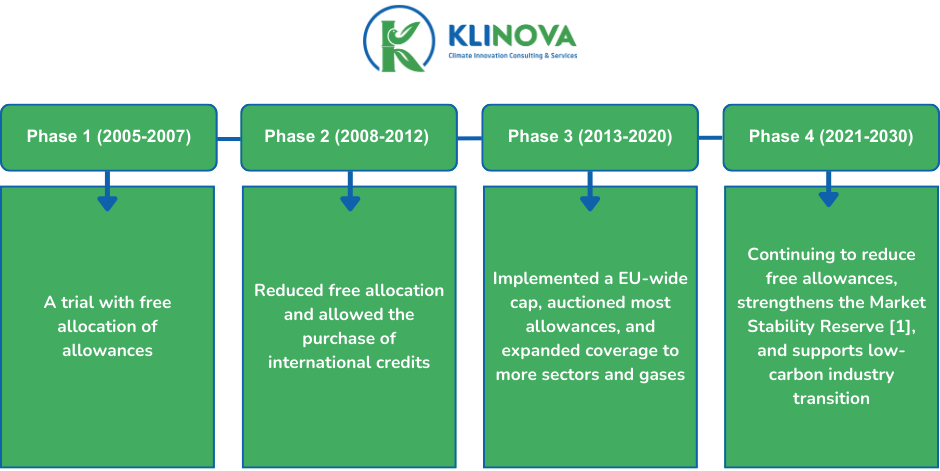Europe is a pioneer in establishing and operating carbon and greenhouse gas emission trading markets with the aim of controlling and reducing emissions at the lowest cost. The EU Emissions Trading Scheme (EU ETS) is the world's first compliance carbon market.
1. Overview of the EU ETS
The European Union Emission Trading Scheme (EU ETS) is the world’s first international emissions trading system and a key policy tool for the EU to achieve its climate neutrality goal by 2050, as outlined in the European Green Deal (EGD) and their Kyoto Protocol commitments. Set up in 2005, it operates in four phases:

2. Scope of the EU ETS
The EU ETS currently operates across 28 EU countries, Iceland, Liechtenstein, Norway, and limits greenhouse gas (GHG) emissions from approximately 11,000 energy-intensive businesses (e.g., power generation, steel, cement, aviation) [2]. Since January 2024, the EU ETS has been extended to cover CO2 emissions from all large ships (of 5 000 gross tonnage and above) entering EU ports [3].
3. Operation Mechanism
The EU Emissions Trading System (EU ETS) operates on the “cap and trade” principle, where the cap represents the total limit of GHG emissions allowed for installations within the system. This cap is reduced annually to align with the EU’s climate targets. If emissions exceed the allocated cap, businesses are required to purchase credits to offset the excess or face a standard penalty of 100 EUR per ton of CO₂, as stipulated by EU regulations. A list of non-compliant installations is published annually.
The EU ETS cap is expressed in emission allowances (EU Allowances - EUA) with one allowance giving the right to emit one tonne of CO2 eq (i.e., carbon dioxide equivalent). The EUA are partially allocated for free, with the remainder being purchased through an auction mechanism. Allowances can also be traded between installations when necessary. The price of EUA is determined by the EU carbon market and is subject to strict regulatory oversight. All transactions are recorded in the Union Registry, ensuring transparency and accountability.
4. Recent updates
In 2023, the EU revised ETS with a tighter cap to bring emissions down by 62% by 2030 compared to 2005 levels, including emissions from maritime transport. Additionally, a new emissions trading system called ETS2, will be launched in 2027 to address CO₂ emissions from fuel combustion in buildings, road transport, and other sectors (primarily small industries not covered under the current system) [4].
References:
[1] This mechanism was established by the EU in 2015 to reduce surplus emissions allowances and enhance the market’s resilience to future challenges, more details at: https://climate.ec.europa.eu/eu-action/eu-emissions-trading-system-eu-ets/market-stability-reserve_en, accessed on December 25, 2024.
[2] European Commission, EU ETS Handbook:
https://climate.ec.europa.eu/document/download/5dee0b48-a38f-4d10-bf1a-14d0c1d6febd_en?filename=factsheet_ets_en.pdf, accessed on December 25, 2024.
[3] More information at: https://climate.ec.europa.eu/eu-action/transport/reducing-emissions-shipping-sector_en, accessed on December 25, 2024.
[4] European Commission, Our ambition for 2030:
https://climate.ec.europa.eu/eu-action/eu-emissions-trading-system-eu-ets/what-eu-ets_en#our-climate-ambition-for-2030, accessed on December 25, 2024.